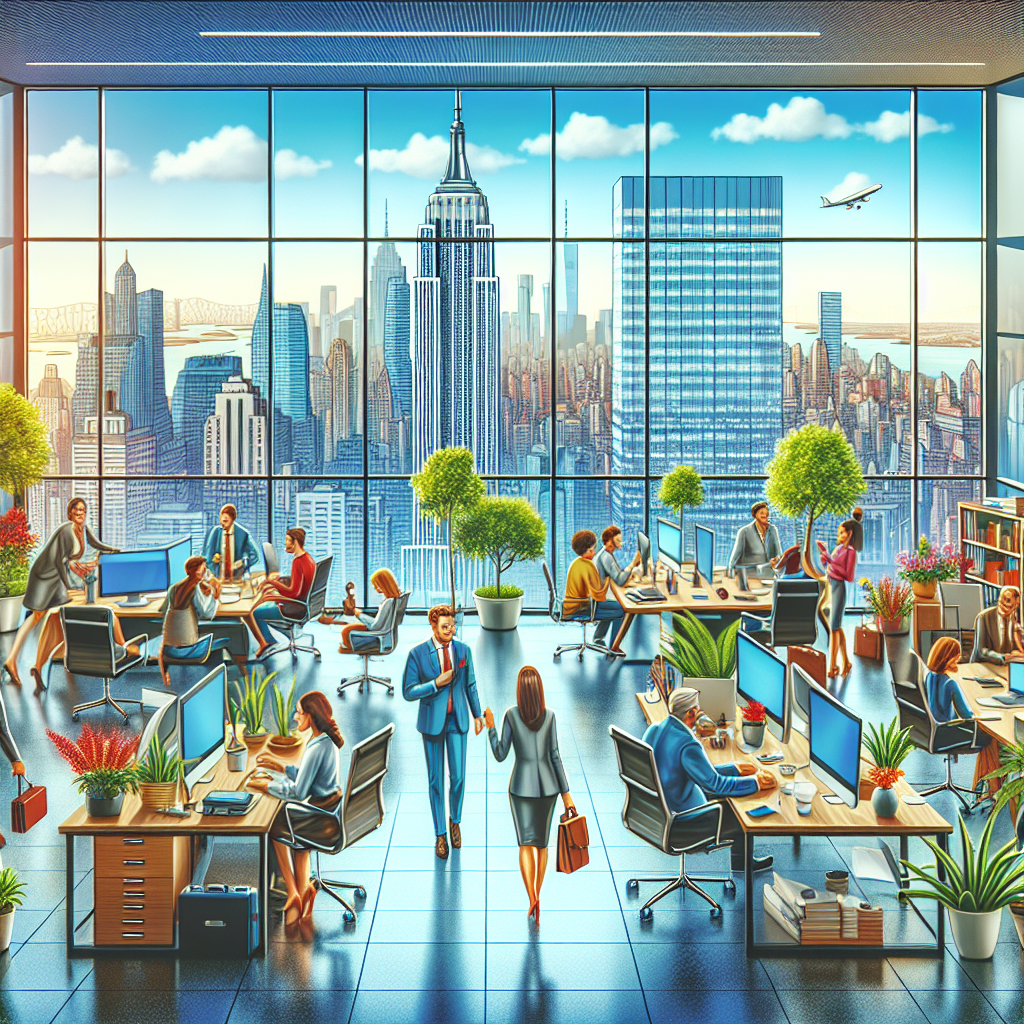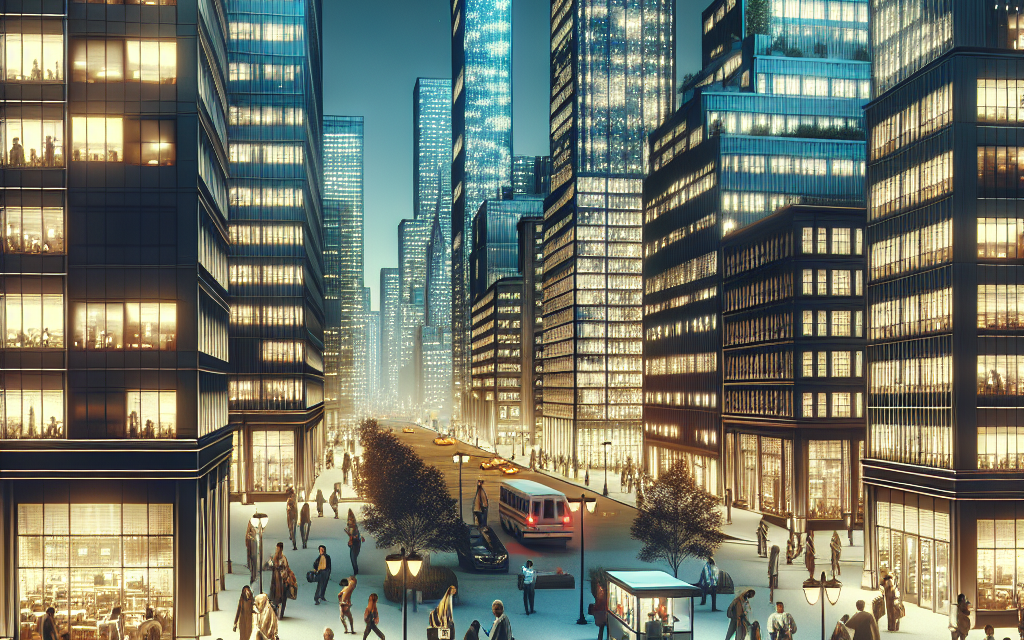“Reviving the Hustle: NYC Workspaces Flourish as Remote Work Fades”
Introduction
As the world gradually emerges from the shadow of the pandemic, New York City is witnessing a significant shift in its work culture landscape. The era of remote work, once deemed the future of employment, is seeing a decline as businesses and employees alike gravitate back to traditional office environments. This transition marks a resurgence for NYC workspaces, which are thriving as companies recognize the value of in-person collaboration and the dynamic energy of the city. With the return to office gaining momentum, New York’s commercial real estate market is experiencing a revitalization, and the city’s vibrant business districts are bustling once again. This shift not only underscores the resilience of the Big Apple’s economy but also highlights the enduring appeal of face-to-face interactions in fostering innovation and productivity.
The Evolution of NYC Workspaces: Adapting to Post-Pandemic Realities
As the world gradually emerges from the shadow of the COVID-19 pandemic, the landscape of work is undergoing a significant transformation. Nowhere is this more evident than in New York City, a metropolis renowned for its dynamic business environment and iconic skyline. The initial surge in remote work, once seen as a permanent shift, is now giving way to a renewed interest in traditional office spaces. This evolution is driven by a combination of factors, including the inherent value of in-person collaboration, the limitations of remote work, and the innovative adaptations of NYC workspaces to meet post-pandemic realities.
Initially, the pandemic forced businesses to adopt remote work as a necessity, leading to a widespread belief that this model would become the new norm. However, as the situation stabilizes, companies are reassessing the long-term viability of remote work. Many organizations have discovered that while remote work offers flexibility, it also presents challenges in terms of maintaining company culture, fostering collaboration, and ensuring productivity. Consequently, there is a growing recognition of the unique benefits that physical office spaces provide, prompting a gradual return to traditional work environments.
In response to this shift, NYC workspaces are evolving to accommodate the changing needs of businesses and employees. One of the most significant adaptations is the redesign of office layouts to prioritize health and safety. Open-plan offices, once celebrated for their collaborative potential, are being reimagined with a focus on social distancing and personal space. Companies are investing in advanced ventilation systems, touchless technologies, and enhanced sanitation protocols to create environments that prioritize employee well-being.
Moreover, the concept of hybrid work models is gaining traction, blending the advantages of remote work with the benefits of in-person collaboration. This approach allows employees to enjoy the flexibility of working from home while still having access to the resources and social interactions that office spaces offer. As a result, many NYC companies are adopting flexible scheduling and shared workspaces, enabling employees to choose when and how they work in the office. This shift not only enhances work-life balance but also maximizes the use of office space, making it a more sustainable option for businesses.
Furthermore, the resurgence of in-person work is driving innovation in the design and functionality of NYC workspaces. Companies are increasingly investing in technology to facilitate seamless communication and collaboration between remote and on-site employees. Video conferencing tools, digital whiteboards, and collaborative software are becoming integral components of modern office environments, ensuring that all team members can contribute effectively, regardless of their location.
In addition to technological advancements, there is a growing emphasis on creating workspaces that inspire creativity and foster a sense of community. Many NYC offices are incorporating elements such as green spaces, art installations, and wellness amenities to enhance the overall work experience. These features not only attract talent but also contribute to employee satisfaction and retention, further solidifying the value of physical office spaces.
In conclusion, the decline of remote work and the resurgence of traditional office environments in New York City reflect a broader trend of adaptation and innovation. As businesses navigate the post-pandemic landscape, they are recognizing the enduring importance of in-person collaboration and the unique advantages that physical workspaces offer. By embracing hybrid models, prioritizing health and safety, and investing in technology and design, NYC workspaces are thriving in this new era, setting a precedent for the future of work.
How NYC Companies Are Redesigning Offices for a Hybrid Work Model
As the landscape of work continues to evolve, New York City companies are at the forefront of redesigning office spaces to accommodate a hybrid work model. This shift comes as businesses seek to balance the benefits of remote work with the undeniable advantages of in-person collaboration. The transition from fully remote work to a hybrid model has prompted organizations to rethink their office environments, ensuring they are conducive to both productivity and employee well-being.
To begin with, many companies are reimagining their office layouts to foster collaboration and flexibility. Traditional office designs, characterized by rows of cubicles and closed-off meeting rooms, are being replaced with open, adaptable spaces. These new designs often feature movable furniture, allowing teams to reconfigure their work areas as needed. This flexibility not only supports dynamic teamwork but also accommodates varying group sizes and activities. By creating spaces that can be easily adjusted, companies are better equipped to meet the diverse needs of their employees.
In addition to flexible layouts, technology integration plays a crucial role in the redesign of office spaces. As hybrid work models require seamless communication between remote and in-office employees, companies are investing in advanced technological solutions. High-quality video conferencing systems, interactive whiteboards, and robust Wi-Fi networks are becoming standard features in modern offices. These technologies ensure that all team members, regardless of their physical location, can participate fully in meetings and collaborative efforts. By bridging the gap between remote and in-person work, technology enhances the overall efficiency and effectiveness of hybrid teams.
Moreover, the emphasis on employee well-being has become a central consideration in office redesigns. Companies are increasingly aware of the impact that physical environments have on mental health and productivity. As a result, many organizations are incorporating elements such as natural lighting, indoor plants, and ergonomic furniture into their office spaces. These features not only create a more pleasant and inviting atmosphere but also contribute to the overall health and satisfaction of employees. By prioritizing well-being, companies are fostering a positive work culture that supports both individual and collective success.
Furthermore, the hybrid work model has led to a reevaluation of office amenities. With employees spending less time in the office, companies are focusing on quality over quantity when it comes to amenities. Instead of offering a wide range of services, businesses are investing in amenities that enhance the in-office experience. This might include state-of-the-art fitness centers, quiet zones for focused work, or communal areas designed for social interaction. By providing meaningful amenities, companies are encouraging employees to make the most of their time in the office, thereby strengthening team cohesion and morale.
In conclusion, as remote work declines and hybrid models gain traction, New York City companies are proactively redesigning their office spaces to meet the demands of this new era. Through flexible layouts, advanced technology, a focus on well-being, and carefully selected amenities, businesses are creating environments that support both productivity and employee satisfaction. As these redesigned workspaces continue to evolve, they will undoubtedly play a pivotal role in shaping the future of work in one of the world’s most dynamic cities. By embracing these changes, companies are not only adapting to current trends but also setting the stage for long-term success in an ever-changing work landscape.
The Impact of Remote Work Decline on NYC’s Commercial Real Estate Market
As the world gradually emerges from the shadow of the COVID-19 pandemic, the landscape of work is undergoing a significant transformation. In New York City, a metropolis renowned for its vibrant business environment, the decline of remote work is having a profound impact on the commercial real estate market. This shift back to traditional office settings is not only reshaping the way companies operate but also revitalizing the city’s commercial spaces, which had been left underutilized during the height of the pandemic.
Initially, the pandemic forced businesses to adapt swiftly to remote work, leading to a dramatic reduction in the demand for office space. Companies across various sectors embraced the flexibility of remote work, resulting in a surge of vacant office buildings in New York City. However, as the situation stabilizes and the benefits of in-person collaboration become increasingly apparent, many organizations are re-evaluating their long-term strategies. Consequently, there is a noticeable trend of businesses returning to physical office spaces, thereby breathing new life into the city’s commercial real estate market.
One of the primary drivers behind this shift is the recognition of the value of face-to-face interactions. While remote work offers convenience and flexibility, it often lacks the spontaneous exchanges and collaborative energy that occur in a shared physical environment. Many companies have found that in-person meetings foster creativity, enhance communication, and strengthen team dynamics. As a result, businesses are increasingly prioritizing a return to the office to harness these benefits, leading to a resurgence in demand for commercial real estate.
Moreover, the decline in remote work is prompting a reevaluation of office space design and utilization. Companies are now seeking to create workspaces that are not only functional but also conducive to employee well-being and productivity. This has led to a growing interest in flexible office layouts, incorporating open spaces, collaborative zones, and wellness amenities. As businesses invest in modernizing their office environments, commercial real estate developers are responding by offering innovative solutions that cater to these evolving needs.
In addition to the changing preferences of businesses, the decline of remote work is also influencing the broader economic landscape of New York City. The return of employees to office spaces is revitalizing local businesses that rely on foot traffic, such as cafes, restaurants, and retail stores. This resurgence in economic activity is contributing to the overall recovery of the city’s economy, which had been severely impacted by the pandemic-induced downturn.
Furthermore, the renewed demand for office space is driving a competitive market, with landlords and property owners striving to attract tenants by offering attractive lease terms and amenities. This competition is fostering a dynamic environment where innovation and creativity are paramount, ultimately benefiting both businesses and employees.
In conclusion, the decline of remote work is having a significant impact on New York City’s commercial real estate market. As companies recognize the value of in-person collaboration and seek to create dynamic work environments, the demand for office space is on the rise. This shift is not only revitalizing the city’s commercial spaces but also contributing to the broader economic recovery. As New York City continues to adapt to the evolving work landscape, the commercial real estate market is poised to thrive, reflecting the resilience and adaptability of this iconic metropolis.
Employee Perspectives: The Benefits of Returning to NYC Offices

As the world gradually emerges from the shadow of the pandemic, the landscape of work is undergoing a significant transformation. In New York City, a metropolis synonymous with ambition and innovation, the return to office spaces is gaining momentum. This shift is not merely a logistical adjustment but a profound change that is reshaping the way employees perceive their work environments. While remote work offered undeniable advantages during a time of global uncertainty, many employees are now recognizing the multifaceted benefits of returning to their NYC offices.
One of the most compelling reasons for this shift is the sense of community and collaboration that physical office spaces foster. In a city as dynamic as New York, the energy of in-person interactions is unparalleled. Employees often find that face-to-face communication enhances creativity and problem-solving, as spontaneous discussions and brainstorming sessions can lead to innovative solutions. The serendipitous encounters in hallways or during coffee breaks, which are difficult to replicate in virtual settings, often spark new ideas and strengthen professional relationships.
Moreover, the return to office life in NYC offers employees a clearer delineation between work and personal life. During the height of remote work, many individuals struggled with maintaining boundaries, as the lines between professional and personal spaces blurred. Commuting to an office provides a structured routine that helps employees mentally transition between their roles at work and home. This separation can lead to improved focus and productivity during office hours, as well as a more fulfilling personal life outside of work.
In addition to these psychological benefits, the physical environment of NYC offices plays a crucial role in enhancing employee well-being. Many companies have invested in redesigning their workspaces to prioritize health and comfort, incorporating elements such as ergonomic furniture, improved air quality, and natural lighting. These enhancements not only contribute to a more pleasant work atmosphere but also support the physical health of employees, reducing the risk of issues such as eye strain and musculoskeletal problems that can arise from prolonged periods of remote work.
Furthermore, the return to office spaces in New York City provides employees with access to a wealth of resources and amenities that are often unavailable at home. From state-of-the-art technology and equipment to on-site fitness centers and dining options, these facilities can significantly enhance the work experience. Additionally, being in the heart of NYC allows employees to take advantage of the city’s vibrant cultural scene, whether it’s attending networking events, visiting museums, or enjoying the diverse culinary offerings during lunch breaks.
While the transition back to office life may present challenges, such as adjusting to commuting and navigating new health protocols, the benefits for employees are substantial. The opportunity to engage in meaningful face-to-face interactions, establish a clear work-life balance, and enjoy a supportive and resource-rich environment are compelling reasons for many to embrace this change. As NYC workspaces continue to thrive, employees are finding renewed motivation and satisfaction in their professional lives, underscoring the enduring value of the traditional office setting in an increasingly digital world.
NYC’s Co-Working Spaces: A Solution for the Transition Back to Office
As the world gradually emerges from the shadow of the pandemic, the landscape of work is undergoing a significant transformation. In New York City, a metropolis renowned for its dynamic business environment, the shift from remote work back to traditional office settings is becoming increasingly evident. This transition, however, is not a simple reversal to pre-pandemic norms. Instead, it is characterized by a nuanced blend of flexibility and structure, with co-working spaces playing a pivotal role in facilitating this change.
The decline in remote work can be attributed to several factors. Employers are recognizing the value of in-person collaboration, which often fosters creativity and innovation more effectively than virtual interactions. Moreover, the spontaneous exchanges that occur in physical workspaces can lead to serendipitous ideas and solutions that are less likely to emerge in a remote setting. Consequently, many companies are encouraging their employees to return to the office, albeit with a more flexible approach than before.
In this evolving work environment, co-working spaces have emerged as a viable solution for businesses and employees alike. These spaces offer a unique blend of flexibility and community, catering to the diverse needs of modern professionals. For companies, co-working spaces provide an opportunity to maintain a physical presence without the long-term commitment and overhead costs associated with traditional office leases. This is particularly advantageous for startups and small businesses that require agility in their operations.
For employees, co-working spaces offer a refreshing alternative to both the isolation of remote work and the rigidity of a conventional office. These spaces are designed to foster collaboration and networking, providing individuals with the opportunity to engage with professionals from various industries. This cross-pollination of ideas can lead to innovative solutions and partnerships that might not have been possible in a more insular work environment. Furthermore, co-working spaces often come equipped with modern amenities and technology, ensuring that workers have access to the tools they need to be productive.
The rise of co-working spaces in New York City is also reflective of broader trends in urban development and real estate. As companies reassess their office space requirements, there is a growing demand for flexible work environments that can adapt to changing needs. Co-working spaces, with their ability to offer short-term leases and customizable layouts, are well-positioned to meet this demand. Additionally, these spaces often occupy prime real estate locations, providing businesses with a prestigious address without the associated costs.
Moreover, the social aspect of co-working spaces cannot be overlooked. After months of remote work, many employees are eager to reconnect with colleagues and rebuild their professional networks. Co-working spaces facilitate this by hosting events, workshops, and networking sessions, creating a vibrant community atmosphere. This sense of belonging and engagement can significantly enhance employee satisfaction and well-being, which in turn can lead to increased productivity and retention.
In conclusion, as New York City navigates the transition back to office work, co-working spaces are proving to be an invaluable asset. They offer a flexible, cost-effective solution for businesses while providing employees with a dynamic and collaborative work environment. As the city continues to adapt to the changing demands of the modern workforce, co-working spaces are likely to play an increasingly important role in shaping the future of work.
Technology Integration in NYC Offices: Enhancing In-Person Collaboration
As the landscape of work continues to evolve, New York City offices are witnessing a significant shift back to in-person collaboration, driven by a decline in remote work. This transition is not merely a return to traditional workspaces but rather an opportunity to integrate advanced technology to enhance collaboration and productivity. The resurgence of office attendance in NYC is being met with innovative solutions that blend the best of both worlds—physical presence and digital connectivity.
To begin with, the integration of technology in NYC offices is redefining how teams collaborate. With the decline of remote work, companies are investing in state-of-the-art tools that facilitate seamless communication and project management. For instance, interactive digital whiteboards and smart meeting rooms equipped with high-definition video conferencing capabilities are becoming standard. These technologies allow for real-time collaboration, enabling team members to brainstorm and share ideas as if they were in the same room, even if some participants are joining remotely. This hybrid approach ensures that the benefits of remote work, such as flexibility and accessibility, are not lost in the transition back to the office.
Moreover, the emphasis on technology integration is fostering a more dynamic and engaging work environment. Employees are no longer confined to their desks; instead, they can move freely within the office, utilizing mobile devices and cloud-based applications to access information and collaborate with colleagues. This mobility is supported by robust wireless networks and secure data management systems, ensuring that employees can work efficiently from any location within the office. As a result, the physical workspace is being transformed into a hub of activity and innovation, where ideas can flow freely and projects can progress rapidly.
In addition to enhancing collaboration, technology integration in NYC offices is also addressing the need for flexibility and adaptability. As businesses navigate the post-pandemic landscape, the ability to quickly adapt to changing circumstances is crucial. Advanced scheduling software and resource management tools are enabling companies to optimize their use of office space, ensuring that meeting rooms and workstations are utilized effectively. This not only maximizes productivity but also supports a more sustainable approach to office management, reducing energy consumption and minimizing waste.
Furthermore, the return to office work in NYC is accompanied by a renewed focus on employee well-being, with technology playing a pivotal role. Smart building systems are being implemented to monitor and control environmental factors such as lighting, temperature, and air quality, creating a more comfortable and healthy work environment. Additionally, wellness apps and platforms are being integrated into the workplace, offering employees access to mental health resources, fitness programs, and other support services. By prioritizing employee well-being, companies are fostering a more engaged and motivated workforce, which in turn enhances collaboration and productivity.
In conclusion, the decline of remote work in New York City is not simply a return to the status quo but an opportunity to reimagine the office as a space that combines the best aspects of in-person and remote work. Through the strategic integration of technology, NYC offices are becoming more collaborative, flexible, and supportive environments. As businesses continue to adapt to the changing work landscape, the focus on technology-driven solutions will undoubtedly play a crucial role in shaping the future of work in the city.
The Role of NYC’s Public Transportation in Supporting Office Return
As the world gradually emerges from the shadow of the COVID-19 pandemic, the landscape of work is undergoing a significant transformation. In New York City, a metropolis renowned for its vibrant business environment, the return to office spaces is gaining momentum. This shift is not only reshaping the way companies operate but also highlighting the critical role of the city’s public transportation system in facilitating this transition. With remote work declining, the intricate network of subways, buses, and commuter trains is once again becoming the lifeline for countless professionals commuting to their workplaces.
The resurgence of in-person work in New York City is driven by several factors. Companies are increasingly recognizing the value of face-to-face collaboration, which fosters creativity, innovation, and a sense of community among employees. Moreover, the limitations of remote work, such as feelings of isolation and challenges in maintaining work-life boundaries, have prompted many organizations to encourage a return to the office. As a result, the demand for reliable and efficient public transportation has surged, underscoring its indispensable role in supporting this transition.
New York City’s public transportation system, operated by the Metropolitan Transportation Authority (MTA), is one of the most extensive in the world. It serves as a vital artery, connecting the city’s diverse neighborhoods and enabling millions of people to commute to work daily. The MTA’s efforts to enhance safety and reliability have been pivotal in restoring confidence among commuters. Rigorous cleaning protocols, improved ventilation systems, and the implementation of contactless payment options have contributed to a safer and more convenient commuting experience.
Furthermore, the MTA has been proactive in addressing the evolving needs of commuters. By expanding service hours and increasing the frequency of trains and buses, the authority has ensured that public transportation remains a viable option for those returning to the office. This adaptability is crucial in accommodating the varied schedules of workers, many of whom are navigating hybrid work models that require flexibility in commuting options.
In addition to operational improvements, the MTA has also focused on sustainability initiatives, aligning with the broader goals of reducing the city’s carbon footprint. The introduction of electric buses and the expansion of bike-sharing programs are steps towards creating a more environmentally friendly transportation system. These efforts not only contribute to a cleaner city but also resonate with the growing emphasis on corporate social responsibility among businesses.
The role of public transportation in supporting the return to office spaces extends beyond mere logistics. It is a catalyst for economic recovery, as increased ridership translates into higher revenue for local businesses. Restaurants, cafes, and retail stores situated near transit hubs are witnessing a revival, benefiting from the foot traffic generated by commuters. This economic ripple effect underscores the symbiotic relationship between public transportation and the city’s commercial vitality.
In conclusion, as New York City navigates the complexities of a post-pandemic world, the return to office spaces is a testament to the resilience and adaptability of its workforce. The city’s public transportation system plays an integral role in this transition, providing a reliable and sustainable means for professionals to reconnect with their workplaces. By continuing to prioritize safety, efficiency, and sustainability, the MTA is not only facilitating the return to office but also contributing to the broader revitalization of the city’s economy. As remote work declines, the bustling energy of New York City is once again palpable, driven by the seamless integration of its public transportation network into the daily lives of its residents.
Q&A
1. **Question:** What is the main focus of the article “Return to Office: NYC Workspaces Thrive as Remote Work Declines”?
**Answer:** The article focuses on the resurgence of in-person workspaces in New York City as remote work trends decline.
2. **Question:** How has the decline in remote work affected NYC workspaces?
**Answer:** The decline in remote work has led to a thriving environment for NYC workspaces, with increased occupancy and demand.
3. **Question:** What factors are contributing to the decline of remote work in NYC?
**Answer:** Factors include company policies mandating in-office presence, the desire for collaboration, and the availability of improved office amenities.
4. **Question:** What impact has the return to office had on local businesses in NYC?
**Answer:** The return to office has positively impacted local businesses, boosting sales and foot traffic in areas surrounding office buildings.
5. **Question:** Are there any challenges mentioned in the article regarding the return to office trend?
**Answer:** Yes, challenges include employee resistance to commuting, balancing hybrid work models, and ensuring health and safety in the workplace.
6. **Question:** How are companies incentivizing employees to return to the office?
**Answer:** Companies are offering incentives such as flexible work schedules, enhanced office facilities, and social events to encourage employees to return.
7. **Question:** What is the long-term outlook for NYC workspaces according to the article?
**Answer:** The long-term outlook is optimistic, with expectations of continued growth and adaptation to hybrid work models, ensuring the relevance of physical workspaces.
Conclusion
The resurgence of in-person work in New York City is revitalizing local workspaces as remote work trends decline. This shift is driven by companies seeking to enhance collaboration, culture, and productivity through physical presence. As a result, office spaces are experiencing increased demand, leading to economic benefits for surrounding businesses and the real estate market. The transition underscores a balancing act between flexibility and traditional work environments, highlighting the evolving nature of work in a post-pandemic world.





